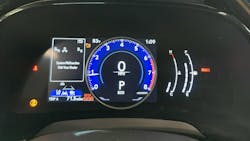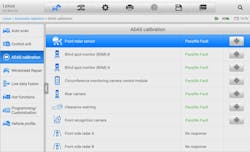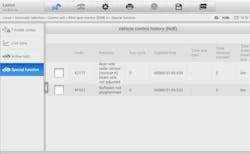Hidden ADAS information: 'A guy named RoB'
One of the body shops I service was working on a 2023 Lexus RX350 (Figure 1) with a complaint of instrument cluster lights on. The vehicle was involved in a major rear end collision with repairs done to the bumper and the right rear quarter panel.
The shop finished all the repairs and performed a post scan on the entire vehicle to make sure there were no underlying issues that needed further attention. To their surprise, there were no codes in the system, but there were icons lit up on the dash. Confused about this inconsistency, they called me in for technical assistance.
When I arrived at the shop, they presented me with a scan report of the vehicle. But I could plainly see there were no codes on the report pertaining to any issues with the vehicle. When I started the car, I noticed icons for the rear side blind spot system and park assist off (Figure 2).
It seemed a little odd. Hoping for different results, I tried using my scan tool, which is a different brand than they used. When I scanned the vehicle, I had the same results using a topology format of my tool. In this mode, you can visually see every active module on the network and look at their color status to see if any codes were stored (Figure 3). The modules were green, indicating no codes in the vehicle computer networks.
It was now time to start the interrogation process on this vehicle because I didn’t know where to turn next without having more clues to this puzzle. I asked the shop if they had replaced any electronic components during the repairs. They had told me that the right rear quarter panel was damaged from the hit, so as a precautionary measure they replaced the blind spot module. I knew from experience that these modules are usually plug-and-play but do need a calibration process as a post procedure. But usually there would be a code set for “alignment not completed.” So, at this point I decided to go ahead and perform the calibration and hopefully the blind spot error on the dash would be erased.
I migrated over to my ADAS software and performed an ADAS scan, which showed all the systems being okay with no errors (Figure 4). Then I selected the blind spot A from the menu, which on this particular vehicle is on the right rear side of the vehicle. An interesting precautionary screen showed up first to alert me about this particular vehicle. It stated that if the dashboard had a fault lamp on and the diagnostic tool could not read any main trouble codes, then you need to direct yourself to the control unit in question and go under the Functional Procedures to look for “vehicle control history record,” or “RoB,” as it is called in the Toyota/Lexus world.
So, this “guy,” “Rob,” I’ll call him, apparently stores all history records of errors for the specific module that happen over time with a “key cycle counter” as well as a “last distance traveled since set counter.” The historical records would have to be all cleared in that particular module in order to see which one stays behind as the culprit creating the light on the dash to be illuminated. The crazy thing here is that these historical codes have nothing to do with the actual trouble codes stored in the main “codes menu” and could easily create confusion for any technician working on this vehicle.
So, at this point I backed out of the ADAS menu and went to visit RoB under the Functional Procedures Menu to see what problems were stored within the right rear blind spot module that I chose as the possible culprit. I was VERY surprised to see the history codes that were stored in memory (Figure 5). There was a RoB code X2177 stating that the beam axis was not adjusted and also another RoB code F021 stating that software in the module was not programmed. This was all disturbing to me, and it went against the grain about everything I learned in the field over the years with module replacement. You would think that the manufacturer would place this information in the code menu, but instead they hide it with a guy named RoB in a different menu of the module.
This was definitely a game-changer for me. I’ve adapted my strategy for working on newer Toyota and Lexus vehicles. I now need to put RoB in my toolbox of diagnostics for these manufacturers.
So, at this point I had to break out my new Toyota/Lexus web-based scan tool, the Global TechStream Plus, or GTS+, to reprogram the blind spot and 4x4 control modules (Figure 6). This is a new scan tool software that was recently released for late 2023 vehicles and newer and will soon be used to migrate the older vehicles and eventually get rid of the old TechStream software. Once I logged in with this server-based scan tool using my username and password, I performed a full health check scan report of the entire vehicle.
The GTS+ is very user-friendly and its color format really draws your attention to any areas of concern by using highlighted colors (Figure 7). It immediately highlighted the 4x4 module and the blind spot “A” module as needing to be configured with new software by putting a red “Yes” in the configuration column. When I confronted the shop about the 4x4 module, they told me they forgot to mention that they had also replaced a small module located in the right rear corner of the trunk but did not think much about it. All I have to say was that if this tool did not alert me about the 4x4 module, I probably would have had a 4x4 light coming up on that dash at one point or another and yet with no codes in the system.
I also noted some information that needs to be alerted to the vehicle owner. There was a RoB code P05CE00 in the engine control module for a cold start “B” camshaft position timing performance bank 1 issue but yet there were no engine codes Stored in memory. There was a “service bulletin available” highlighted in a red “Yes” link and an engine control module software update that was available also highlighted in a red “yes” link. The GTS+ tool is definitely a valuable asset for working on newer Lexus and Toyota vehicles.
The GTS+ scan tool had a RoB column that showed you a green dot for every module in the car that had a history record stored. At this point there were nine modules that had history records. So, I went ahead and looked into all nine modules one at a time to get an overview of what was stored. The interesting thing was I also found out why the parking aid system was in the “park off” mode. There was a RoB code X20C1 for "ultrasonic rear sensor ID not registered." The shop forgot to tell me that one of the parking sensors was also replaced. So, now I had my work cut out for me. It all started out as just two icons on the dash with no codes on a complete post scan, but now this vehicle needed much more than post procedures performed. This involved reprogramming both the 4x4 and right rear side radar control modules and a full calibration of both the rear side radar unit and the rear parking sensors. I used the GTS+ to seamlessly reprogram both the 4x4 and right rear side radar control modules with the latest software.
Then I set up my targets to calibrate the rear side radar system and the rear parking sensors. My final move was to use the RoB delete button at the bottom of my scan tool menu to delete every control module of its onboard-stored RoB records. The unfortunate thing is that my aftermarket tool cannot perform this task. If I were to use it, I would have to go into each control module one at a time to clear out the RoB records. This could be a huge task, given that some of these Lexus and Toyota vehicles have up to 35 controllers onboard. You have to do this as an added post procedure because any RoB codes left behind could put many of the onboard systems into failsafe mode. You could possibly have RoB codes stored in the ABS control module that may leave the park assist off light on with no menu codes or RoB codes stored within the park assist system control module that would send you on a wild goose chase.
So, I have learned so much from this one job and it has helped me to form a new relationship with RoB. This dude is sneaky and will hold information in his report center without any menu codes being on a post scan report. I am sure as time goes on, the aftermarket scan tools will add the RoB full vehicle scan as a new feature in their tool. But until then, you need to add RoB to your arsenal of diagnostic approaches and make sure no newer Lexus or Toyota vehicle leaves your shop without clearing all the RoB records stored on board. I hope this article will enhance what you know or didn’t know about this "guy named RoB."
About the Author

John Anello
Owner and operator of Auto Tech on Wheels
John Anello is the owner and operator of Auto Tech on Wheels, established in 1991 in northern New Jersey. He provides technical assistance and remote reprogramming with 21 factory PC-based scan tools. Driven by a passion for cars, John's business now services roughly 1,700 shops.






